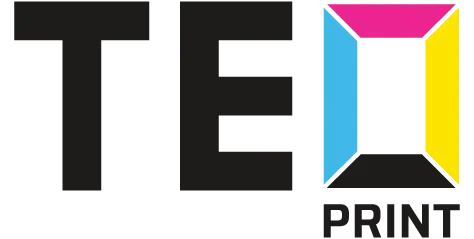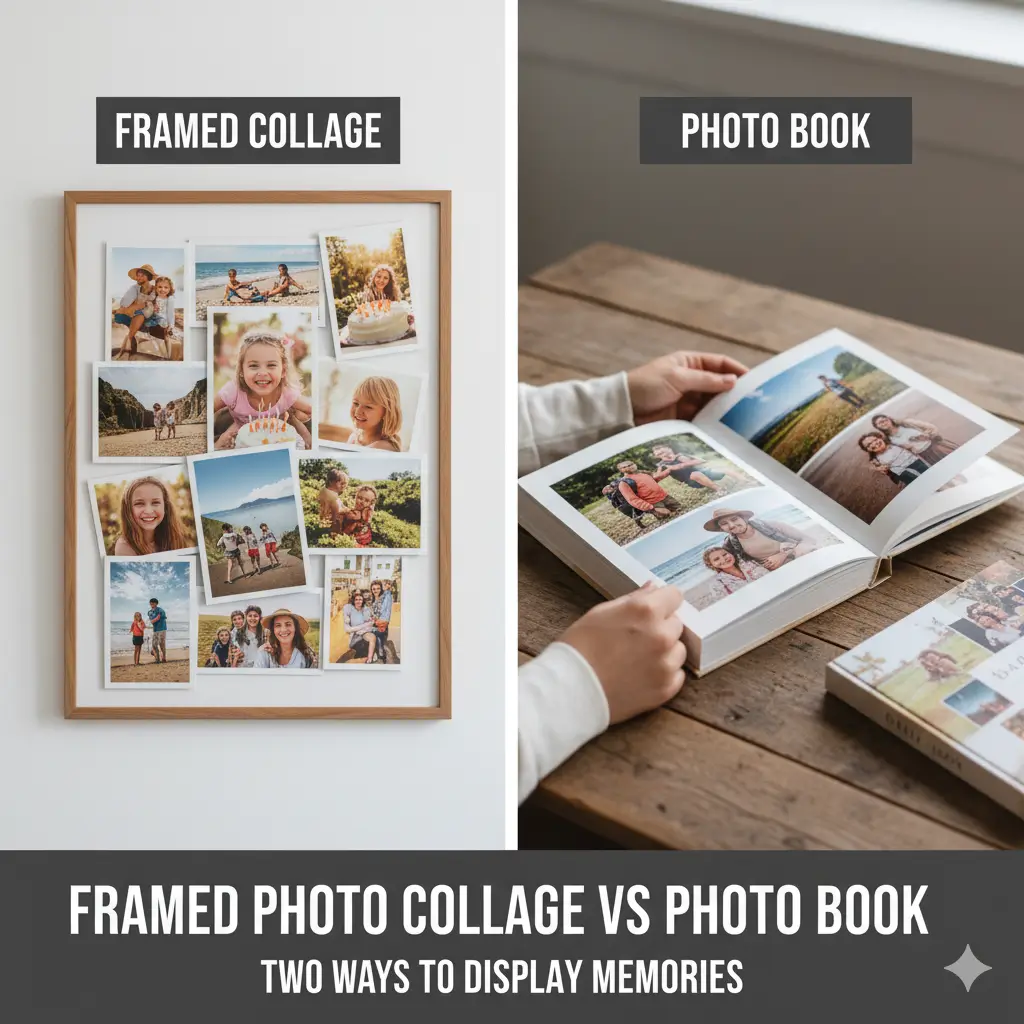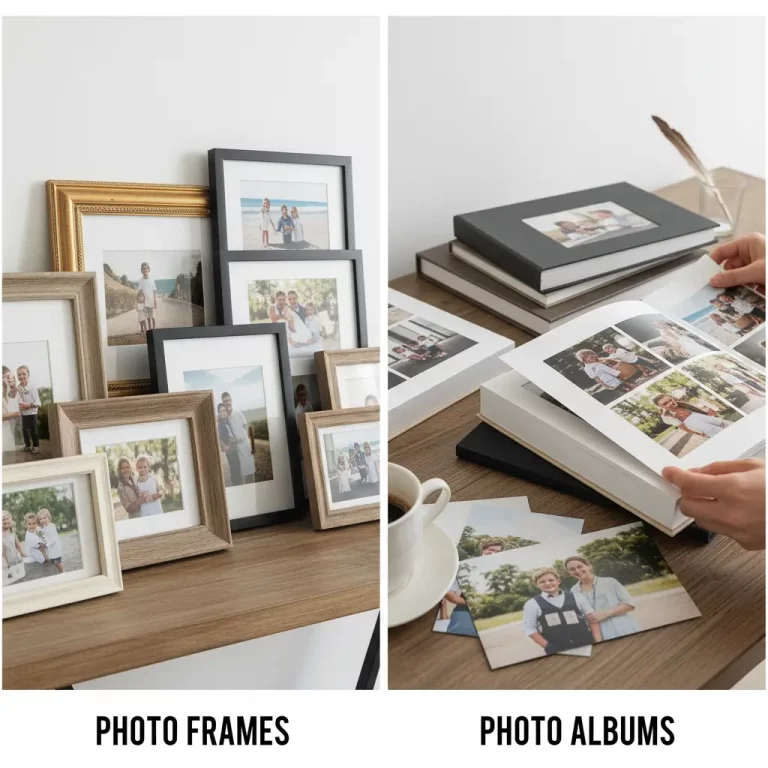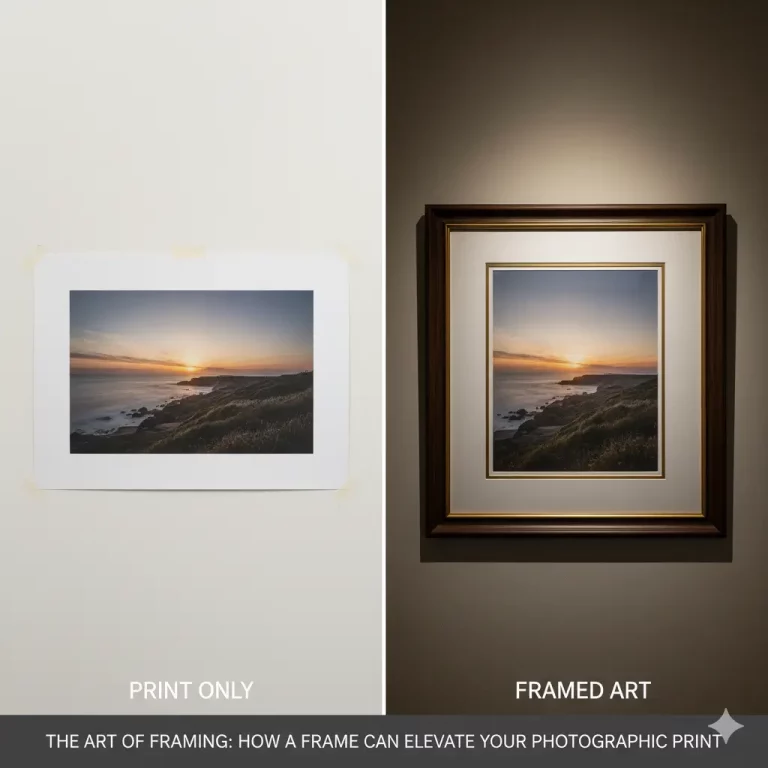In an age where our photos often live on phones and cloud servers, the act of bringing them into the physical world feels more meaningful than ever. Tangible memories connect us to our past and allow us to share our stories in a way that scrolling through a digital gallery cannot. When it comes to showcasing a collection of moments—like a family vacation, a wedding, or a baby’s first year—two popular methods stand out: the photo collage frame and the photo book.
Both options gather multiple images into a single, cohesive narrative, but they do so in very different ways. A photo collage frame offers a static, artful display for your wall, while a photo book creates an intimate, story-driven experience you can hold in your hands. Choosing between them depends on your purpose, your space, and the story you want to tell. This guide will compare the photo collage frame and the photo book to help you decide which is the perfect vessel for your cherished memories.
The Photo Collage Frame: A Visual Statement
A photo collage frame is a single frame designed to display multiple photos at once. It can come in various forms, from frames with pre-cut mat openings for several standard-sized photos to large, open frames where you can create a free-form arrangement. It serves as a piece of wall art that is both decorative and deeply personal.
Aesthetics and Wall Decor
The primary strength of a photo collage frame lies in its visual impact. It acts as a statement piece, consolidating many memories into a single focal point on your wall. This method is perfect for creating a “snapshot” of a specific event or time period. A well-designed collage can capture the energy of a wedding day or the joy of a family reunion in a single glance.
This format allows for creative expression through layout, color coordination, and frame style. You can choose a sleek, modern frame with a grid layout for a clean look or a rustic, multi-sized frame for a more eclectic, bohemian vibe. The frame itself becomes part of the decor, tying into the room’s overall aesthetic and enhancing the visual appeal of your home.
Functionality and Display
A photo collage frame is designed for permanent or semi-permanent display. Once hung, it becomes a constant, visible reminder of the moments it holds. This makes it ideal for showcasing cornerstone memories—the ones you want to see every day.
However, this permanence is also its main limitation. Updating the photos can be a cumbersome process, often requiring you to take the frame down, open the back, and rearrange everything. For this reason, collage frames are best suited for timeless collections rather than photos you plan to swap out frequently. If you do enjoy seasonal updates, our tips on swapping photos in frames can make the process easier.
Pros and Cons of a Photo Collage Frame
Pros:
- High Visual Impact: Creates a single, powerful piece of wall art.
- Decorative: The frame itself contributes to your home’s decor.
- “At a Glance” Viewing: Allows you to see multiple related moments at once.
- Great for Themed Displays: Perfect for summarizing an event like a vacation, wedding, or graduation.
Cons:
- Limited Capacity: You can only display a handful of photos compared to a photo book.
- Difficult to Update: Swapping out photos can be a significant undertaking.
- Requires Wall Space: You need a dedicated spot on your wall for display.
- Static Story: It presents a single snapshot rather than a detailed narrative.
The Photo Book: A Narrative Journey
A photo book is a professionally printed and bound book featuring your personal photographs. Modern printing services make it easy to design custom layouts, add text, and create a high-quality book that rivals those found in a bookstore. It allows you to tell a detailed story, page by page.
Aesthetics and Storytelling
The true power of a photo book is its ability to weave a narrative. You are not limited to a handful of images; you can include dozens or even hundreds of photos, guiding the viewer through a journey. You can arrange photos chronologically to document a child’s growth, a travel adventure, or a year in review. The addition of captions, dates, and anecdotes adds context and emotional depth that a collage frame cannot offer.
This format provides immense creative control. You can design custom page layouts, choose different backgrounds, select font styles, and decide on the book’s size, cover type (hardcover, softcover, layflat), and paper finish (matte, glossy). The final product is a polished, personal, and comprehensive archive of your memories.
Functionality and Accessibility
A photo book is designed for interaction. It lives on a coffee table or a bookshelf, ready to be picked up, shared, and enjoyed. This makes it a wonderfully intimate and communal experience. Families can gather around to flip through a vacation album, or you can quietly revisit memories on a cozy evening.
Unlike a wall display, a photo book is portable and doesn’t require any wall space. It is also easily stored, allowing you to create an entire library of memories over the years—one for each major life event or family year. This format is perfect for comprehensive collections and detailed storytelling.
Pros and Cons of a Photo Book
Pros:
- Large Capacity: Can hold hundreds of photos, telling a complete story.
- Narrative Potential: Allows for chronological storytelling with text and captions.
- Portable and Shareable: Easy to pass around, share with guests, and store on a bookshelf.
- Highly Customizable: Offers extensive control over layout, design, and materials.
Cons:
- Not a Constant Display: It must be actively taken out to be viewed.
- Design Time: Creating a well-designed photo book can be time-consuming.
- Cost Can Add Up: While a basic book is affordable, high-end options with many pages can become expensive.
- Less Immediate Impact: It doesn’t serve as a piece of home decor in the same way a framed collage does.
How to Choose: Collage Frame or Photo Book?
The best choice depends on your specific goals. Ask yourself the following questions to find the right fit for your memories.
1. What is the scope of your story?
- Choose a photo collage frame if: You want to highlight a few “greatest hits” from an event. Think of it as a movie poster that captures the essence of the story.
- Choose a photo book if: You want to tell the whole story, with all the details, from beginning to end. This is the full movie, complete with character development and a detailed plot.
2. Where do you want to display your memories?
- Choose a photo collage frame if: You have a specific wall space you want to fill, and you want your memories to be a constant part of your home’s decor.
- Choose a photo book if: You prefer your memories to be accessible on a coffee table or bookshelf, ready for interactive viewing.
3. How many photos do you want to include?
- Choose a photo collage frame if: You have 3 to 15 standout images that work well together visually.
- Choose a photo book if: You have 20 to 200+ photos that document an entire experience.
4. What is your budget and time commitment?
- Choose a photo collage frame if: You want a relatively quick project. You can arrange the photos and have a finished product in a short amount of time. The cost is a one-time purchase of the frame and prints.
- Choose a photo book if: You are willing to invest time in designing layouts and curating a large collection of photos. The cost will vary based on the number of pages, cover type, and paper quality.
Ultimately, you don’t have to choose just one. A photo collage frame and a photo book can work together beautifully. Use a collage frame on your wall to showcase the single best photo from each of your family’s yearly adventures, while a detailed photo book for each trip sits on the shelf, ready to tell the full story whenever you want to relive the journey. Both formats offer a wonderful way to honor your memories, ensuring they are seen, shared, and cherished for years to come.





